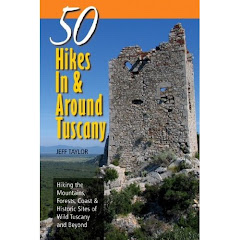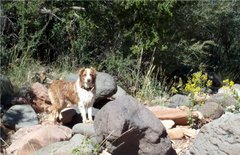Distance: 3-5 miles round trip (4.8 - 8.0 km)
Elevation: 7300 - 5500 feet (2225 - 1670 m)
Difficulty: Strenuous
Season: March-November
Want to have a sample experience of the Grand Canyon without descending the full 5000 feet to the river?
Jeff and Hilina in the Coconino Sandstone Layer
The Kaibab trail down to Cedar Ridge is the trail for you. The trail starts at the Kaibab Trailhead near Yaki Point and requires you to get on the park shuttle to access. The trail desends through several of the sedimentary layers that makes up the Grand Canyon. It starts on the South Rim in Kaibab Limestone and quickly switchbacks down several times before reaching a more level area as it heads out toward the Cedar Ridge.
The trail soon descends through ledgy Toroweap limestone and then into the Coconino Sandstone. The Coconino sandstone is obvious as it is the primary material that makes up the light colored vertical cliffs of the upper portion of the canyon. Up close it is obvious by the angled cross-bedding typical of ancient sand dunes. This is the same formation that makes up Walnut Canyon National Monument near Flagstaff.
The trail is in good condition, except for the large juniper logs you have to climb over every few feet. These logs are designed to prevent erosion from eating away the trail. This is particular true due to the mules that use this trail to get people and equipment to the bottom of the canyon.
The Taylor-Lenz Family at Ooh Ahh Point
At about 1 mile, the trail comes to a major switchback where the first views to the east up the canyon are visible. This site is known as Ooh Ahh Point. There is no sign, but you will know when you are there. This is a turn around point for many people, as you have already descended 600 feet in elevation.
View from Ooh Ahh Point: the red area below is Cedar Ridge and the butte further out is O'Neil Butte
But, if you have it in you, Ooh Ahh Point is not where to stop! The trail soon descends down to a shelter on a red colored, wide, flat ledge below. This is Cedar Ridge and the expansive views, available water and toilets make this a worthwhile place to eat lunch.
The red shaly rocks of this ridge are in the Supai Formation. This formation also happens to be the same material that the red rock country of Sedona is made of! Cedar Ridge offers spectacular views down to the inner rim and the 1.8 billion year old Vishnu Schist of the inner canyon. Unfortunately, you can not see the river from here. But, Cedar Ridge gives you an amazing feel of what its like to be
IN Grand Canyon!
View into the Inner Gorge from O'Neill Butte - notice the dark Vishnu Schist and white granite dikes
If you have not had enough of descending into the canyon, there is another nice spot another half mile of so called O'Neil Butte. This tall butte is obvious and there is a saddle with even nicer views of the inner rim, which is made up of light Tapeat Sandstone. The saddle sits on top of the next most obvious layer of the Grand Canyon, which is the Red Wall Limestone. This is the second major vertical cliff formation of the canyon.
O'Neill Butte
Ironically, the Redwall Limestone is not actually red like it appears, but white. The red color comes from staining of the surface from erosion of the red Supai formation above it. Another 30 minutes further down and another 1000 feet is where the first great views of the river occur at Skeleton Point at the end of the ridge in the light colored Muav Limstone.
Linda and Hilina at Cedar Ridge
Basically, you can turn back any time you want. But, keep this in mind...What goes down, must come back up! It is a strenuous hike back up. So, while the canyon may be calling you down, you may be dreading the haul back up! Also, remember it gets hotter the further down you go, with temps approaching 100 degrees in the lower canyon in summer. So, be prepared with plenty of water and hike outside the heat of the day.
The climb back up from Cedar Ridge to the South Rim


















































